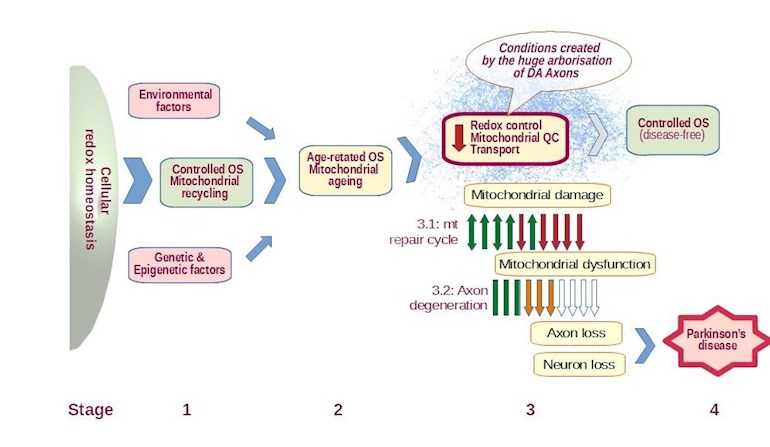Hello everyone. This is work in progress. I invite you to download the Pdf file and give me your opinion of how easy this is to understand and any other comments you wish to make.
Parkinson’s disease is characterized by the loss of dopaminergic neurons in the substantia nigra in the midbrain and a deficit of dopamine in the terminal synapses in the striatum, but a simple model presenting the stages leading up to this condition has so far not been presented.
Here I proposes a simplified model that schematically represents the chronology of the major events that I believed are involved in the pathogenesis of Parkinson’s disease in a way designed to be accessible to patients. The model also proposes which steps may be subject to influence through medical or patient intervention, so that patients can make informed decisions about how to manage their own condition. The model covers the progression of Parkinson’s disease from benign redox imbalance in brain cells to chronic oxidative stress which initiates a cascade of two major events: (i) mitochondrial dysfunction, a condition which reduces the energy available to host cells and (ii) degeneration of vulnerable axons in the striatum region of SN neurons as a consequence of this energy loss. The model links these major events and draws attention to the considerable delays occurring between the beginning of the events and the observation of symptoms eventually produced by them, a situation which masks the true progression of the disease.
To build this model, evidence for the three major conditions already identified in the progression of Parkinson’s disease; age-related oxidative stress, mitochondrial damage and loss of dopaminergic SN neurons was investigated. There are convincing arguments for the processes that link these conditions and make up the basic version of the model. Each process has also been examined in more detail to consider the potential roles other factors having the capacity to modify or invalidate the primary model, such as α-synuclein, genetic variants, toxins or lifestyle. These additional factors add complexity to the model but help to understand how the pathogenesis and development of Parkinson’s disease is multifactorial. This article presents only the simplified model only.
This model has yet to be fully proven, but identifying the different processes opens up the possibility of researching appropriate therapy to slow the disease. Two particular processes that fit this condition are oxidative stress and mitochondrial dysfunction. Both of these work synergistically to create degeneration in axons of dopaminergic neuron in the striatum, far from the nucleus of these neurons which are located in the substantia nigra.
The main file is available via this link : patientresearcher.com/2021/...
